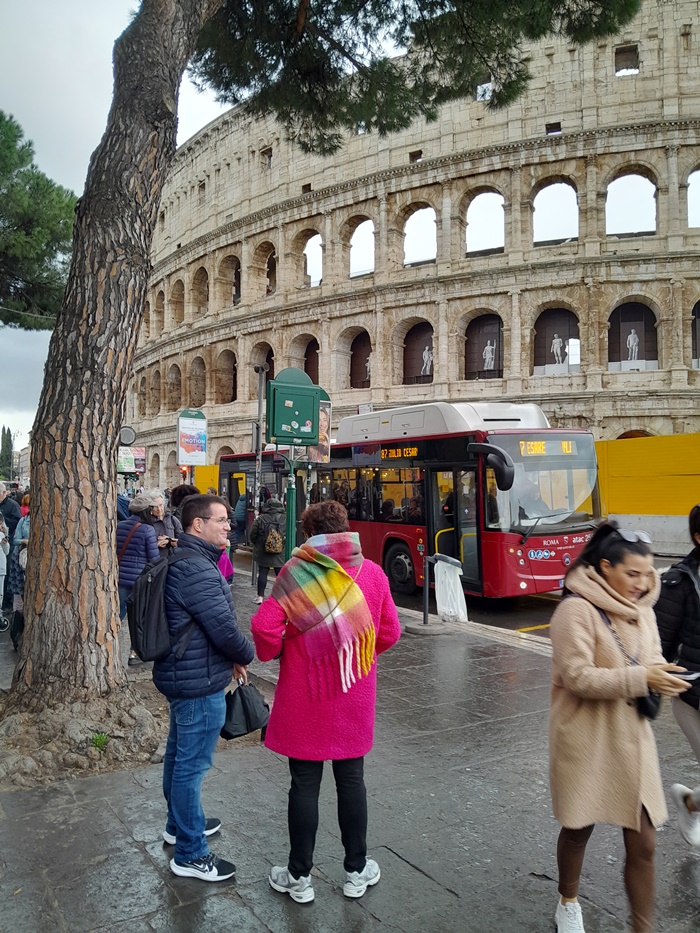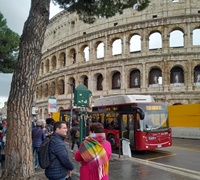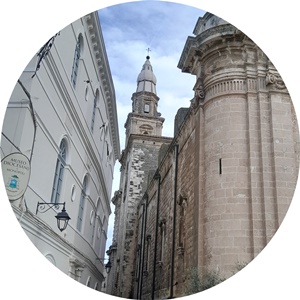- Home
- Rome on a Budget
Rome on a Budget: Travel Smart, See More
We love to visit Rome all year round, whether for exploring the Colosseum in a completely new way, discovering new places for eating amatriciana or gelato, or hunting for kitchen items and food souvenirs. Our visits range from extended stays to quick city breaks, and sometimes we just make brief stopovers when heading to Florence.
Since we try to visit frequently (we managed 3 trips last year), we're always looking for ways to save money on transportation, accommodation, meals, and attraction tickets in Rome. We've gathered plenty of useful tips and tricks for experiencing Rome without breaking the bank.
We're happy to share our budget-friendly findings with you, including affordable places to stay, economical dining spots, and how to access free or discounted attractions. Keep reading for all our money-saving secrets to help you explore Rome on a budget.
 The magic of Rome in winter captivates us with its quieter streets and budget-friendly prices, far from the summer tourist rush.
The magic of Rome in winter captivates us with its quieter streets and budget-friendly prices, far from the summer tourist rush.Affordable accommodation in Rome
You don't have to spend a fortune to stay somewhere special in Rome. Especially if you are travelling of the season. You can find hotels and apartment half-price in November and December (until Christmas) and then again in January and February. The prices slightly drops also in August, but that Rome is deserted from locals in that month, because summer holidays.
We will list here great Rome hotels and apartments we stayed in so far. Whether you're looking for a five-star hotel, a room in a villa or comfortable room in a boutique B&B, there's a place on our list to suit everyone. Here are our favourite affordable hotels in Rome.
- Ripetta 35
- Borghetto Guest House
- Smart Guesthouse Termini
- Residenza Romana
Budget-friendly places to eat in Rome
Worried about expensive dining in Rome? Save money by choosing casual eateries over sit-down restaurants.
The city's streets are packed with food spots offering mouthwatering fresh-made treats. You'll discover pizza al taglio (pizza cut into squares or rectangles), tasty sandwiches (like focaccia stuffed with prosciutto or mortadella), supplì, arancini, various Italian pastries (plain or filled with custard, chocolate or pistachio cream), traditional cannoli (Sicilian pastry), and smooth gelato... We have a couple of dining places we love in Rome!
If you're planning to visit, check out our page about Rome's best food tours (while they're an additional expense, you can find reasonable options like the €39 street food tour). These tours let you sample delicious food, connect with fellow travellers, and get insights into daily Roman life.
Rather than paying several euros for water at tourist attraction stands, grab a bottle from a café or, even better, a local grocery store. Once empty, keep the bottle and take advantage of Rome's 1,500+ flowing fountains. These fountains provide safe, refreshing drinking water that's completely free - just refill and go.
Check out Pinsa Mpo, a cosy spot in Via dei Gracchi (just minutes from the Vatican Museums) serving excellent pinsa (Rome's signature oval pizza) for dine-in or takeout.
Staying at an apartment? Visit local grocery stores to cook simple pasta dishes using quality ingredients. The city's open markets offer amazing selections of fruits, vegetables, meats, seafood, fresh pasta, and breads...
Not in a cooking mood? These markets also sell prepared dishes like parmigiana di melanzane or porchetta (herb-stuffed roasted pork).
Another option: create a quick meal with fresh bread, some pecorino cheese, prosciutto slices, and fruit.
We recommend Trionfale market (perfect if you're in the Prati area) - it's got everything needed for a delicious meal.
Most Italian supermarkets include prepared food sections where you can find budget-friendly lunch or dinner options.
Free and low-cost sightseeing in Rome
Rome's city center is essentially a free open-air museum, packed with incredible sights that won't cost you anything to enjoy. You can marvel at famous spots like the Trevi Fountain and Spanish Steps without spending a dime, and the same goes for the stunning Baroque artwork decorating public spaces like Piazza Navona.
Want to see some of Italy's finest art, sculpture, and ancient ruins? Just step into any of Rome's churches - they're all free! While everyone knows St Peter's Basilica, don't overlook smaller gems like San Pietro in Vincoli, home to Michelangelo's Moses. The Basilica of San Clemente is another must-see - for just €10, you can explore its fascinating underground levels, featuring medieval frescoes and ancient Roman living spaces, including a mysterious pagan temple.
For the best value, especially if you're planning to see multiple sites and use public transport, grab a Roma Pass. The 72-hour version (€52) includes free entry to your first two attractions (including popular spots like the Colosseum, Galleria Borghese, and Capitoline Museums), discounts on other sites, unlimited public transport, and some nice perks like skip-the-line access at the Colosseum and free P.Stop bathroom access. Just remember - while the pass gives you great deals, you'll still need to book your attraction visits online in advance.
🌟 Quick Rome Trip Planner

🚆 1. Book Your Train to Rome
Catch a fast train to Rome from Florence, Venice, Milan, or Naples, or board the Leonardo Express if you land at Fiumicino.
🚗 2. Arrange a Car Transfer to Rome
If you’re flying into Fiumicino Airport ✈️, pre-book a comfy private car transfer to your hotel/apartment.
🏠 3. Find the Perfect Stay
From historic palazzos converted into stylish B&Bs to luxury hotels with rooftop views of the Eternal City, Rome has accommodation to suit every kind of traveller. We love to stay at Laurina 33 Guesthouse and Sophie Terrace Hotel!
💡 Tip: Reserve well in advance, particularly in peak season — the most popular spots get snapped up fast!
🌺 4. Plan Activities in & from Rome
- Stroll through Rome’s timeless streets and soak in the golden-hour glow at Piazza Navona ✨
- Explore ancient wonders like the Colosseum, Roman Forum, and Pantheon 🏛️
- Take a day trip to gems like Tivoli, Ostia Antica, or Orvieto 🚆
-
Join a pasta-making class or enjoy a food and wine tasting — pure Roman joy! 🍝🍷
🚙 5. Rent a Car for Your Italian Road Trip
Find affordable car rentals to explore the hills, lakes, and historic towns surrounding Rome and beyond. 🛣️
Things to do on a budget in Rome that we love:
- Take a plesant stroll around the city and see some of the amazing sights including the Piazza Navona, the Piazza di Spagna and the Colosseum. Whilst you will be charged for entry into the Colosseum, even seeing it from the outside is impressive – it’s worth a trip at night when it is lit up.
- Visit St. Peter’s Basilica in the Vatican City. Entry to this church is free. Don’t miss the ‘Pietà,’ one of Michelangelo’s most famous statues. You can also climb to the Dome, but your'll need to pay 10 Euros (not recommended for claustrophobic and those with heart problems).
- Visit Il Vittoriano, the large monument not far from the Colosseum. Take a first flight of stairs and you'll get to the terrace from where you can capture amazing photos of the area.
- Take a trip to some of the parks and gardens of Rome including the Parco Gianicolo (where you’ll be treated to a fantastic view of the city) and the gardens at Villa Borghese. You'll escape crowds here and enjoy the nature. You can also rent a bike.
- The Pantheon, a remarkable Roman temple-turned-church, is one of the city's crown jewels. Its incredible dome, built in 125 AD using only concrete and no metal support, is an engineering marvel you have to see to believe. While it's no longer free (as of July 2023), tickets are quite reasonable at €5 for adults and €3 for young adults (18-25). Plus, you can still visit for free on the first Sunday of each month.
- Treat yourself to gelato for just a couple of euros. This is one of our favourite thing to do in Rome.
Smart ways to get around Rome
Rome's compact historic center is best discovered on foot, with treasures waiting around every corner.
For tired travelers, public transport is cost-effective: €1.50 buys 100 minutes of bus travel plus one metro journey. Multi-day passes are available (€7 daily, €18 for three days, €24 weekly), purchasable at metro stations, convenience stores, or newsstands. The Tap & Go system lets you use contactless payments on public transport at the same rates (€1.50 per tap, capped at €7 for multiple rides within 24 hours).
Avoid the pricey Rome taxis - opt for public transport to/from the airport, or use ride-sharing services like Uber.
Skip the tourist buses, including hop-on hop-off services - they're expensive, often inconvenient, and their audio guides are mediocre.
For those undeterred by traffic and hills, e-bikes and e-scooters from Lime, Dott, and Helbiz offer another option. Expect €1 unlock fees plus about 25 cents per minute.
Craving more Italy? Check out these:
Things to do in Monopoli, Puglia
Within this webpage there are some affiliate links for products and services. For more details click here.










